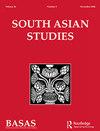Enquiring the Rocks: Statistical Investigation of Buddhist Stupa Carvings at Chilas Bridge, Gilgit-Baltistan, Pakistan
IF 0.7
0 ASIAN STUDIES
引用次数: 0
Abstract
This paper investigates the Buddhist stupa carvings at Chilas Bridge site, District Diamer, Gilgit-Baltistan, Pakistan. We studied a total of 199 stupa carvings using statistical techniques to explore the depiction of Buddhist stupas and their constituent parts in this key region of northern Pakistan. Analysis of the stupa carvings suggests that the majority of the stupas were of small and medium size, primarily oriented in preferred directions and positions. Most of the stupa carvings at Chilas Bridge were depicted at a height/width ratio of 2:1, perhaps reflecting a real artistic and architectural convention following Hinayana Buddhism. The artists at Chilas Bridge appear to have used Gandharan stupa construction techniques as inspiration for developing their own style of stupa carving tradition, which lasted for around 700 years.询问岩石:巴基斯坦吉尔吉特-巴尔蒂斯坦奇拉斯桥佛塔雕刻的统计调查
本文调查了巴基斯坦吉尔吉特-巴尔蒂斯坦迪亚默区奇拉斯桥遗址的佛塔雕刻。我们研究了总共199个佛塔雕刻,使用统计技术来探索巴基斯坦北部这个关键地区佛教佛塔及其组成部分的描绘。对佛塔雕刻的分析表明,大多数佛塔是中小型的,主要朝向偏好的方向和位置。奇拉斯桥上的大多数佛塔雕刻以2:1的高/宽比描绘,也许反映了小乘佛教之后真正的艺术和建筑惯例。奇拉斯桥的艺术家们似乎从犍陀罗佛塔的建造技术中汲取灵感,形成了自己的佛塔雕刻传统风格,这种风格持续了大约700年。
本文章由计算机程序翻译,如有差异,请以英文原文为准。
求助全文
约1分钟内获得全文
求助全文

 求助内容:
求助内容: 应助结果提醒方式:
应助结果提醒方式:


